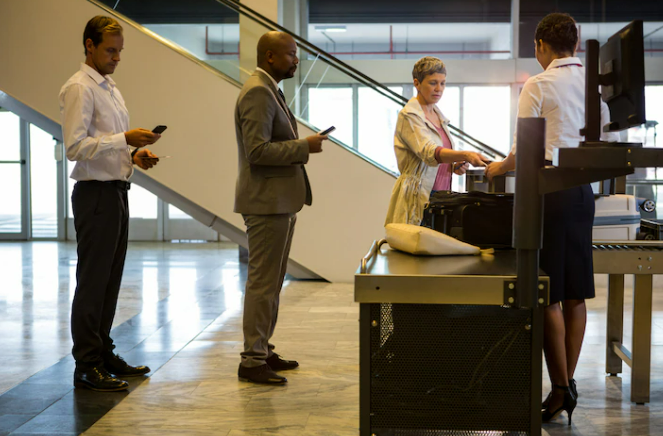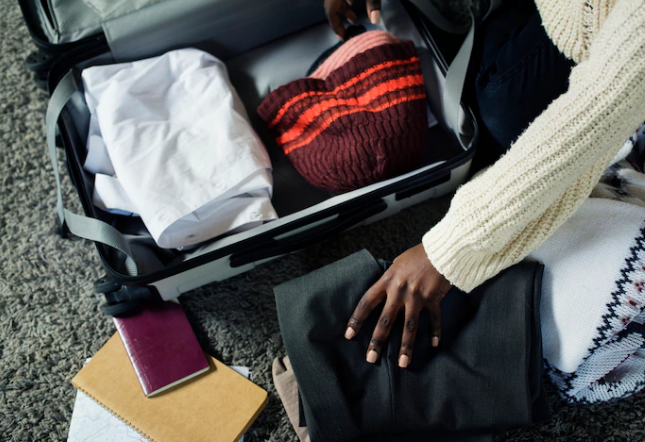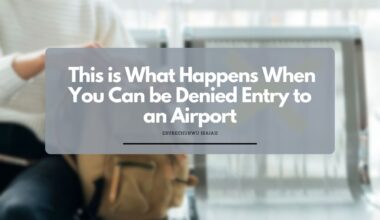As an Amazon Associate, I earn a small commission from qualifying purchases. Learn more about this.
So you’ve just handed over your luggage at the check-in counter, watched it get tagged with your destination, and seen it disappear behind the rubber curtains.
If you’re like most people, this is usually the point where you stop thinking about your bag and start focusing on your own journey.
But have you ever wondered what’s happening to your suitcase while you’re in the security lines and searching for your gate?
What Happens to Luggage after Check In?
1. The Initial Sort
First things first, your luggage is immediately sent off on a conveyor belt system into a sorting area.
Here, baggage handlers and automated systems read the tag that was placed on your luggage at the check-in counter.
This tag contains essential information like your final destination, any connecting flights you may have, and a barcode or RFID chip for tracking purposes.
2. Security Screening
Before proceeding any further, your luggage has to go through security screening.
This process is very similar to the one you go through, albeit tailored for non-human passengers.

High-tech machines scan your bag for prohibited items, and in some cases, a manual search may be conducted.
Rest assured, this is all in the name of safety and security.
3. Automated Systems and Manual Handling
Once cleared by security, your luggage is sorted based on its final destination and any connecting flights.
Modern airports use highly sophisticated automated systems to make this happen. Imagine a network of conveyor belts and chutes that guide each piece of luggage to the appropriate area.
It’s not entirely hands-off, though.
Human intervention is often required for odd-shaped or oversized items, and baggage handlers play a crucial role in ensuring that everything ends up where it’s supposed to.
4. Prepping for the Flight
When it’s almost time for your flight to depart, the sorted luggage is loaded onto carts and driven out to the aircraft.
Keep in mind that it flies in the same plane as you.
There, baggage handlers load the luggage into the cargo hold of the plane, carefully arranging it to ensure an even distribution of weight.
It’s not just a matter of throwing bags onto the plane; there’s a method to the madness to guarantee the aircraft is balanced for safe flying.
Common Reasons for Baggage Delays
When your Baggage is flagged
One common reason for baggage delays is when your bag gets flagged.
We have a whole article on this but let’s spend a second here again.
This might sound a bit technical, but it’s pretty simple.
When your bag is flagged, it means it needs extra checks. This can happen for a variety of reasons – maybe something in your bag looked unusual on the X-ray, or it might be random.
When this happens, your bag is taken aside for a closer look. This extra step is important for safety, but it can cause delays.
Your bag might miss its scheduled flight because of these checks, and then it needs to wait for the next one.
This can be frustrating, I know. I’ve been there, watching the baggage carousel go round and round, with no sign of my bag.
It’s not something that happens often, but it’s good to be aware of it
Human Error
Yes, sometimes it’s as simple as human error. Despite all the high-tech systems in place, humans are still an essential part of the luggage handling process.
A bag could be misrouted, or perhaps a worker accidentally places it on the wrong cart.
Mistakes happen, and even one error can result in your bag taking an unexpected detour. It’s not common, but it’s also not unheard of.
Tight Connection Times
We’ve all been there—rushing through an airport to catch a tight connecting flight. While you might just make it to the gate in time, your luggage might not be so lucky.
Airports often have a minimum connection time that allows both you and your luggage to transfer smoothly, but sometimes, especially if your first flight was delayed, there might not be enough time to transfer your bag to the next flight.
Mechanical Issues
Believe it or not, the complex systems that move luggage around the airport can also experience technical difficulties.
Conveyor belts can break down, and sorting systems can malfunction. When this happens, bags can get delayed as technicians work rapidly to fix the issue.
The good news? Most airports have contingency plans for these types of situations.
Weather Conditions
Mother Nature can be a wild card in the smooth operation of luggage systems.
Extreme weather conditions can lead to flight cancellations, delays, and, consequently, baggage delays.
Snow, heavy rain, and storms can affect both the aircraft and the ground vehicles that transport your luggage from the plane to the baggage claim area.
Related: Do bags that go under the plane get checked?
What Does TSA Look For in Checked Baggage?
Now that we’ve gone over what happens to your luggage once you check it in, you might be wondering about the specifics of the security screening.
I mean, we’ve all had that moment of paranoia thinking, “Did I accidentally leave something restricted in my bag?”
So, let’s get down to the nitty-gritty of what the Transportation Security Administration (TSA) is actually looking for when they scan your checked baggage.
Prohibited Items
First and foremost, TSA is on the lookout for prohibited items.
We’re talking about things like explosives, flammable materials, and other dangerous items that could compromise the safety of the flight.

They also scan for firearms, large knives, and other weapons.
And sometimes this can extend to things like chargers and toys which are obviously not first hand harmful..
If any of these items are found, not only will your bag get flagged, but you could also face serious legal repercussions.
Liquids and Gels Over the Limit
While you can generally pack liquids and gels in your checked luggage, there are still some restrictions.
For example, alcoholic beverages over 140 proof are prohibited.
This is more of a concern for checked bags since carry-on liquids have their own, more stringent set of rules.
Sharp Objects and Tools
You might think that since it’s checked baggage, sharp objects are fair game.
Not exactly.
While it’s generally okay to pack things like razors and scissors, they still should be properly sheathed or securely wrapped to prevent injury to baggage handlers and security personnel.
Chemicals and Special Equipment
TSA also watches for chemicals and special equipment that could be used inappropriately.
Even seemingly innocuous items like a can of spray paint could get your bag pulled aside. Special equipment might include anything that appears to be, or could be used as, a weapon or a tool for tampering.
Oddly Shaped or Dense Items
Sometimes, it’s not about what’s prohibited but rather how items appear on the scanner.
Very dense objects or those with odd shapes may require additional scrutiny to ensure they’re benign. If something looks unusual or unidentifiable, the TSA may open the bag for a more detailed manual check.
Final Thoughts
From the moment we check in our bags to the moment they carousel into our view at the destination, there’s a world of processes and procedures ensuring their safe passage.
Thanks for reading!







